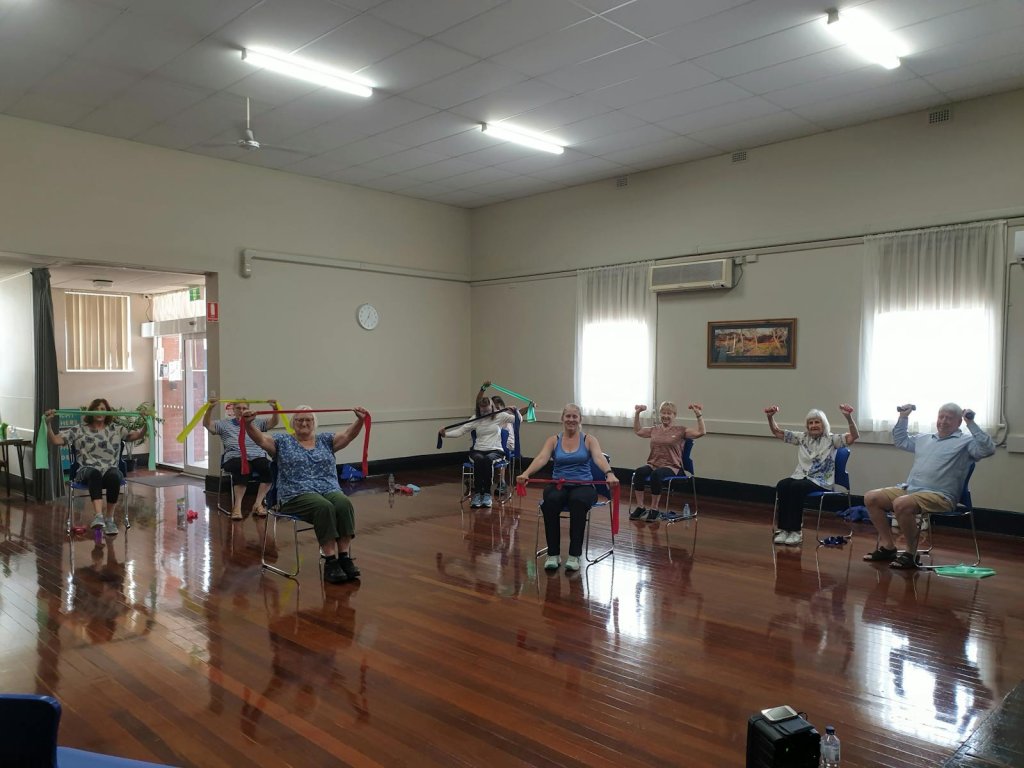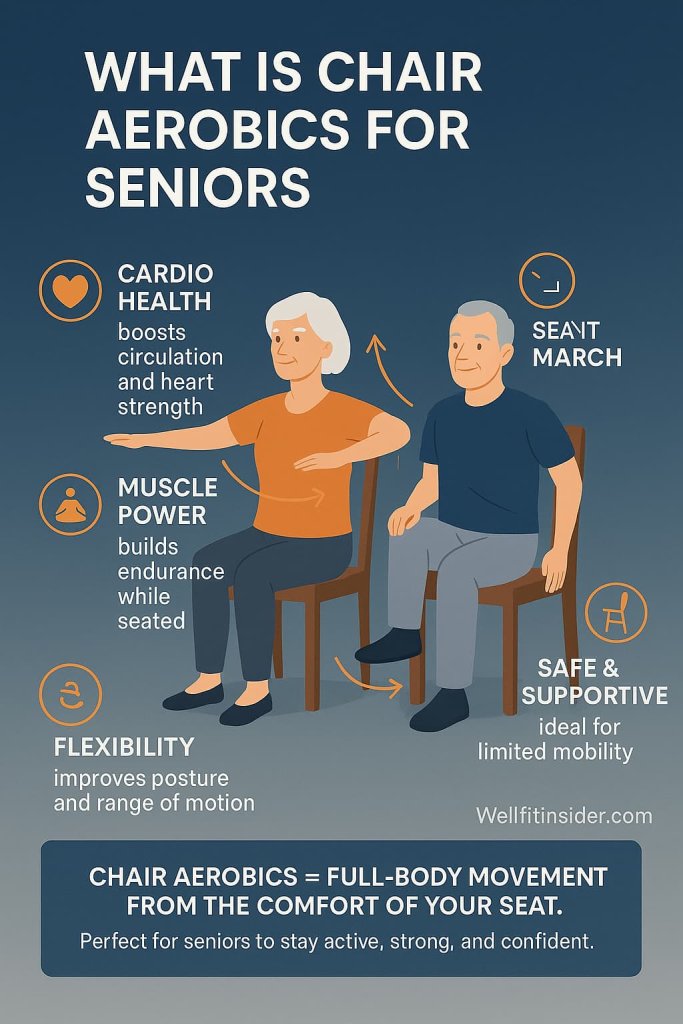Yes — seniors can stay fit, improve heart health, and build strength without ever leaving the chair.
Chair aerobics for seniors combine gentle, seated movements that enhance flexibility, coordination, and stamina — perfect for those with limited mobility or balance concerns.

This form of exercise keeps joints healthy, boosts circulation, strengthens muscles, and lowers the risk of falls. Whether you’re 60 or 90, chair workouts provide a safe, low-impact way to maintain independence and vitality.
According to a 2023 systematic review in the International Journal of Environmental Research and Public Health, chair-based programs significantly improve strength, endurance, and functional mobility in older adults — making them ideal for both home and senior-center routines.
What Is Chair Aerobics for Seniors?
Chair aerobics involves performing aerobic and resistance movements while sitting or holding onto a sturdy chair for support. Exercises can range from simple leg lifts and arm circles to rhythmic seated marches or resistance-band routines.

Core benefits include:
- Improved cardiovascular health
- Enhanced strength and balance
- Better flexibility and posture
- Reduced joint stiffness and fall risk
- Safe option for those recovering from injury or using mobility aids
10 Best Chair Aerobics Exercises for Seniors
Each move below is evidence-based, joint-friendly, and easy to do at home.
Aim for 10–15 reps or 30–60 seconds per exercise, 3–4 times per week.
1. Seated March
Why it works: Improves circulation, warms up the hips and knees, and raises the heart rate for gentle cardio conditioning.
Muscles worked: Hip flexors, lower abdominals, quadriceps, and core stabilizers.
How to do it:
- Sit tall with both feet flat on the floor and your back away from the chair.
- Lift one knee toward your chest, lower it, then lift the other — like marching in place.
- Swing your arms naturally to engage your upper body.
Trainer Tip: Keep your core tight and avoid slouching; this enhances stability and strengthens your lower abs.
2. Arm Circles
Why it works: Increases shoulder flexibility and joint lubrication while improving posture.
Muscles worked: Deltoids, trapezius, and upper back stabilizers.
How to do it:
- Sit upright with your arms extended out to the sides at shoulder height.
- Make small, controlled circles forward for 20 seconds, then reverse the motion.
Trainer Tip: Avoid shrugging your shoulders — keep them down and relaxed to maximize shoulder mobility.
3. Seated Jumping Jacks
Why it works: Offers a full-body, low-impact cardio boost that strengthens both upper and lower body.
Muscles worked: Shoulders, chest, inner and outer thighs, and calves.
How to do it:
- Sit tall with feet together and arms by your sides.
- Simultaneously open your legs out to the sides while raising your arms overhead.
- Return to the starting position and repeat in a smooth rhythm.
Trainer Tip: Keep your core engaged to avoid bouncing; maintain a steady breathing pattern for endurance.
4. Punch and Reach
Why it works: Elevates heart rate while improving coordination and upper-body strength.
Muscles worked: Shoulders, chest, triceps, and upper back.
How to do it:
- Sit upright with your feet hip-width apart.
- Punch one arm forward, then the other.
- Add diagonal or upward reaches for extra range of motion.
Trainer Tip: Use light hand weights or resistance bands for more resistance — but keep movements controlled, not jerky.
5. Seated Knee Extension
Why it works: Strengthens the quadriceps and supports better walking balance and mobility.
Muscles worked: Quadriceps, hip flexors, and lower abdominals.
How to do it:
- Sit upright, feet flat on the floor.
- Extend one leg until it’s straight, hold for two seconds, and lower slowly.
- Repeat on the other side.
Trainer Tip: Add ankle weights for progression; keep the movement slow to maximize muscle engagement.
6. Seated Side Bends
Why it works: Enhances flexibility, core strength, and spine mobility.
Muscles worked: Obliques, intercostals, and lower back stabilizers.
How to do it:
- Sit tall with feet flat on the floor.
- Place one hand behind your head and the other on your thigh.
- Gently bend sideways toward the hand on your thigh, then return to the center.
Trainer Tip: Avoid twisting — move directly to the side to protect your lower back.
7. Toe Taps and Heel Raises
Why it works: Encourages ankle mobility and calf activation to enhance blood circulation in the lower limbs.
Muscles worked: Calves, tibialis anterior, and foot stabilizers.
How to do it:
- Sit tall with feet hip-width apart.
- Tap your toes to the floor, then lift your heels — alternating rhythmically.
- Perform continuously for 30–60 seconds.
Trainer Tip: To increase challenge, perform both movements simultaneously or hold a steady beat to music for cardio engagement.
8. Seated Leg Lifts
Why it works: Strengthens hips and core while improving posture and lower-body stability.
Muscles worked: Hip flexors, quadriceps, and abdominals.
How to do it:
- Sit tall, holding the sides of your chair.
- Lift one leg a few inches off the floor, hold for two seconds, then lower slowly.
- Switch sides and repeat.
Trainer Tip: Keep your chest lifted and core tight — don’t lean back or hunch your shoulders.
9. Seated Side Steps
Why it works: Boosts coordination, activates outer thigh muscles, and provides a light cardio effect.
Muscles worked: Gluteus medius, adductors, and quadriceps.
How to do it:
- Sit on the edge of your chair with feet together.
- Step one foot out to the side, then bring it back in.
- Alternate sides in a smooth, rhythmic motion.
Trainer Tip: Add arm swings or claps to increase cardiovascular demand and fun factor.
10. Seated Cool-Down Stretch
Why it works: Reduces tension, lowers heart rate, and promotes flexibility after your workout.
Muscles worked: Hamstrings, lower back, shoulders, and arms.
How to do it:
- Sit tall with feet flat on the floor.
- Inhale, raising both arms overhead.
- Exhale, slowly bend forward from your hips, reaching toward your toes.
- Hold for 15–20 seconds.
Trainer Tip: Move gently — avoid bouncing. Take deep breaths to help your body relax and recover.
How Often Should Seniors Do Chair Aerobics?
Most experts — including the CDC and National Institute on Aging (NIA) — recommend:
- 150 minutes per week of moderate aerobic activity (about 30 minutes, 5 days a week).
- Mix chair aerobics, light resistance training, and balance exercises for best results.
Chair workouts can be done daily if performed at a light-to-moderate intensity. Always warm up first and listen to your body.
Safety Tips for Seniors
- Use a sturdy, non-rolling chair.
- Wear supportive shoes with rubber soles.
- Start slow — build up intensity gradually.
- Avoid holding your breath; breathe steadily throughout.
- Stop immediately if you feel dizzy, short of breath, or experience pain.
If you have arthritis, heart conditions, or recent surgery, consult a healthcare provider before beginning.
Benefits of Chair Aerobics for Seniors
| Benefit | Description |
|---|---|
| Improved Circulation | Keeps blood flowing, reducing swelling and stiffness. |
| Better Balance | Strengthens stabilizers and reduces fall risk. |
| Joint Health | Lubricates joints through gentle movement. |
| Boosted Mood | Aerobic activity increases endorphins and mental alertness. |
| Accessibility | Can be done anywhere, no special equipment needed. |
A 2023 study in Frontiers in Psychology showed that chair exercise improved both physical function and emotional well-being in older women — proving movement at any level makes a difference.
Sample 15-Minute Chair Aerobics Routine
| Time | Exercise | Focus |
|---|---|---|
| 0–2 min | Seated March | Warm-up |
| 2–4 min | Arm Circles | Mobility |
| 4–6 min | Punch & Reach | Cardio |
| 6–8 min | Seated Side Steps | Coordination |
| 8–10 min | Knee Extensions | Strength |
| 10–12 min | Toe Taps | Endurance |
| 12–15 min | Seated Stretch | Cool-Down |
Research-Backed Evidence
- PMC – Chair-based exercise improves strength and endurance in older adults.
- MDPI Journal (2023) – Seated programs boost grip strength, flexibility, and walking performance.
- Frontiers in Psychology (2021) – Seated aerobic routines enhance mental well-being and fitness in older women.
- WebMD (2024) – Confirms benefits for mobility, strength, and balance with reduced joint stress.
FAQs
1. Are chair aerobics safe for seniors with arthritis?
Yes. Chair workouts reduce joint strain while keeping muscles active and flexible — ideal for arthritis management.
2. How long should a session last?
Start with 10–15 minutes and gradually increase to 30 minutes as endurance improves.
3. Do I need equipment?
No, but light dumbbells, resistance bands, or water bottles can increase intensity safely.
4. Can chair aerobics help with weight loss?
Yes. Combined with a balanced diet, regular chair exercises can improve calorie burn and metabolism.
5. How often should I do them?
Aim for at least 3–5 sessions per week for best results.
6. Can I do chair aerobics if I have balance issues?
Absolutely — the chair provides stability and reduces fall risk, making it one of the safest exercise forms for seniors.
7. What’s the best time of day to do it?
Mid-morning or early afternoon when energy levels are steady. Avoid right after large meals.
Conclusion
Chair aerobics for seniors are one of the safest and most effective ways to stay active, independent, and energized — no gym required.
From improving strength and balance to enhancing mood, these gentle exercises make fitness accessible to everyone. Start with a few minutes daily, stay consistent, and enjoy the benefits of movement at any age.
References
- Furtado GE, et al. (2021). Combined Chair-Based Exercises Improve Functional Fitness and Mental Well-Being in Pre-Frail Older Women. Frontiers in Psychology.
— 14-week study demonstrating improved flexibility, balance, and psychological well-being. - Karatrantou K, et al. (2023). Chair-Based Music-Kinetic Combined Exercise Improves Functional Outcomes in Older Adults. Geriatric Nursing.
— Ten-week program integrating music and movement improved strength and daily performance in participants.
